In regard to one of my Golden Age Comic recaps a few posts back, my friend Scott Casper asked me why I’d not drawn an arguably apt parallel between one of the story’s characters and a highly political present-day TV network. Let me tell you a little story…
I spent a couple of years working as a historian (or “an” historian, if you prefer) for the Maryland Park Service, interpreting several places, periods, and events in American history. My primary job was docent of the Washington Monument State Park museum, which doubled as the visitor center for South Mountain State Battlefield. The monument was first constructed in 1827, played a role in the Battle of South Mountain in 1862, was rebuilt in the 1880’s, and underwent a (hopefully) final construction in its present form when it was rebuilt by the Civilian Conservation Corps (C.C.C.) in the mid-1930’s.
Consequently, I got to talk with a lot of visitors about a lot of different historical periods. It was a really fun and interesting job, one of my favorites in a long career of very diverse and interesting employment. It was challenging, too, because I never knew what each day might bring and what topic the next visitor’s question would be about.
The first year I worked at the museum, in 2009, I noticed a really curious phenomenon: there was no way that I could draw parallels between past history and the present day without something bad happening. One such historical parallel was between the Great Depression and the present-day state of the economy. There were times that I would simply mention that the C.C.C. had been one of FDR’s programs to put the unemployed to work and receive a totally unexpected reaction from a suddenly angry visitor: mad because President Obama had put money into bailouts instead of employing “regular folks who need it”, or spitting on the floor (yes, literally) and calling FDR a “socialist” or, worse (and idiotically), a “fascist”.
In the mid-1820’s, America was celebrating the fiftieth anniversary of the signing of the Declaration of Independence, and was also experiencing one of the most ugly political turmoils in our nation’s history, which we can briefly characterize as a battle between Jacksonian “populists” and the Clay/Adams “elitists”. The subject would come up once in a while when I was asked why the common people of a small Maryland town would decide to put a whole lot of toil and sweat into building a monument to George Washington. It requires a long explanation which I won’t delve into here, other than to say that the 1820’s saw the beginnings of an increased democratization of America, a country which (believe it or not) the Founding Fathers had actually intended to be a republic based around a form of aristocracy (prior to the mid-1820’s, citizens voted directly for House of Representatives candidates only — popular presidential voting was essentially non-binding, and U.S. Senators were appointed, not elected, until the early 20th century).
It’s fascinating stuff – and sometimes when I brought it up the subject would send some visitor into a carpet-chewing, frothing political tirade. I’d be talking about how Adams and Clay threw in together to keep Jackson from winning the 1824 presidential election, then a visitor would go into a rant about modern-day politics, some other visitor would say something back, and a few seconds later the place would be one stone’s throw from a riot.
So I ended up needing to institute a new rule for the museum – no present day political discussion was allowed. Now I’ll admit — I’d bend that rule occasionally if somebody made an analogy and everybody in the room was being civil and polite in discussing or arguing about it. But every so often you’d get one of those visitors who can’t go five minutes without a minor meltdown over politics, and I’d have to invoke “Steve’s rule” just to make sure that every visitor to our park would continue to have a good day.
I’ve become political a few times in old posts to this blog, but I made a conscious decision a short while back to try to keep present day politics out of these virtual pages. I’m highly interested in history (obviously) and I find it to be a very useful tool in trying to make head or tail out of the present and the future; I also know that drawing analogies and parallels between past events and present ones is a great way to help people better understand not only the past, but the present as well.
But I’m not all that interested in useless polemics; I’m not going to get into some Interwebs screaming match with a reader just because my personal politics and theirs conflict. I’d rather just talk about some cool old comic books, throw in a few historical insights when I can (such as the discussion of Gold Star Mothers two posts ago), and we’ll try to have a few chuckles and a good day while we’re at it.
Scott, that’s why I didn’t draw that obvious parallel a few posts back. I’m not a fan of that particular news network; one of their commentators, who was wildly popular at the time I worked in the museum, was a self-styled “historian” who seemed to go out of his way to get everything WRONG (FDR a “fascist”? Really?), and his on-air lunacy made my job as a professional historian and museum docent far more difficult than it should have been. I’m still pretty bitter about it, and I’m not interested in going through that kind of grief again. [*]
[* ADDENDUM 8/17/2017: As most of my readers have been quick to discern, it was the dangerously unhinged (in my decidedly non-professional clinician opinion) Glenn Beck. C’mon, you knew that.]
I will tell everybody right here, right now, that the Roosevelts are two of my favorite U.S. presidents. Since a couple of focuses (or foci, you may have your pick) of this blog are comic books published during FDR’s presidency, and what those books can tell us about the social and political climate of the era, it’s not possible to completely ignore Roosevelt and his rivals (such as the American Liberty League). But I don’t intend to court disaster by drawing comparisons between them and President Obama and the Tea Party (fascinating though such comparisons would be); I have enough trouble in my life without looking for more.
That long winded preamble does tie in with today’s Golden Age comic story, believe it or not…
We’ve been looking at the adventures of The Flag, a short-lived feature published by Ace Magazines (a.k.a. Entwil) from 1941 to 1942. While the series’ art was always good, and sometimes outstanding (as we’ll see in a moment), the stories didn’t quite measure up; the plots holes were often big enough for even the typical ten or eleven year old reader to spot, and The Flag disappeared after just eight adventures.
The Flag just wasn’t very interesting. He was invulnerable, he could fly, he could throw tanks and halftracks around like baseballs, but he had no discernible personality; in fact, his foster father (nicknamed “Old Glory”), despite being a stereotypical “ultra-patriot” character, was a whole lot more accessible to the reader. The Flag ended up being just one among dozens of star-spangled heroes who came and went, but his adventures could have been all-time classics if the characterization and storytelling had matched the quality of the art.
Here, take a look at this (and, as always, click the pic for a larger view):
That’s an awesome splash panel, even if it has bupkis to do with the actual story. The Flag is swarmed by Nazi goons (I especially like the guy chewing on The Flag’s leg) as a passenger train bears down on him. Check out some of the individuals on the crowded platform, most of them watching in horror – but two of the crowd are yelling a warning to The Flag as they gesture toward the oncoming train. That’s some cool stuff!
Of course, this year our country is enjoying the quadrennial three-ring circus known as a presidential campaign; you can’t watch five minutes of TV news without hearing about the candidates’ latest gaffes and antics. So this comic is completely timely and appropriate – just don’t ask me to draw any analogies, for reasons previously stated at great length.
I love the fourth and fifth panels on the page – they remind me of the times when things used to get out of hand in the museum. Old Glory sure is a character, in every sense of the term.
The last three panels sow the seeds of conflict: Kragg’s goons are violating laws against electioneering.
OK, OK, that’s it – stop the action. Three pages into the tale and the story has already arced clear over the top.
If I was headed to the polls and some goons stopped me, roughed me up, and said, “You’re gonna vote for our guy, see?”, you know what I’d do? I’d say, “Sure, Mac! You can count on my vote!”, then I’d go into the booth and vote the way I damn well pleased anyway.
And I’m pretty sure that any kid reading this comic in the 1940’s would say pretty much the same thing.
But that’s a problem from a narrative standpoint. First of all, that would be lying, and that just won’t fly in the context of a patriotic comic: good, average joes and janes don’t lie – only the bad guys do that. Second, if Kragg’s men were to rig the election the good old-fashioned sneaky way — by stuffing the ballot box behind the scenes (“Vote early and often!”) — we wouldn’t have a very dynamic superhero story, would we? Thus more direct action by the villains, no matter how stupid or illogical, is required by the genre. But I will give the writer full props for picking this particular topic and trying to see it through; not many present-day comic writers would take a swing at the subject of rigged elections.
You’re seeing some impressive, dynamic page composition here, with The Flag soaring into action up the entire center of the page. That’s common today, but very atypical of Golden Age comics.
I’ve mentioned before that The Flag’s stories tend to be fairly propaganda-laden, not that I’m complaining – half the reason I read 1940’s comics is to enjoy the unabashed patriotism frequently on display in their pages. But The Flag’s writer and artist just don’t know when to quit, and often lay it on with a trowel.
On this page I did appreciate the panel depicting the Nazi standing behind Kragg (look closely and you’ll notice the swastika armband), particularly because the writer doesn’t call your attention to him: he’s never mentioned in the verbal narrative. But he’s there for an important reason, and we have to notice him to get the message; that’s a really nice (and uncharacteristically subtle) touch.
On the other hand, we also have the two panels featuring the elderly couple. They do serve a narrative purpose: to underscore the dastardly nature of the next stage in Kragg’s plan. But, dang, did the writer and illustrator have to lay it on so thick? I didn’t know whether to laugh or groan.
Please allow me to steal a line from my son Cody: “This just got stupid.” Not the old “movie projection against the clouds” trick, please!
The page’s final panel is killer – the same elderly couple from the previous page, being helped to the bomb shelter by a Boy Scout! I really don’t want to offend anyone here, honestly, and I’m as sentimental as the next guy, but the first time I saw that panel, I hit the floor and rolled – it’s like Norman Rockwell’s evil twin did a heartwarming “Americana” painting called “The Bomb Shelter”.
But what kind of obvious trope will come next? A mother and baby being blown to kingdom come??
NOOOOOO WAY!
The only thing this story is missing is a bus full of nuns careening out of control, about to crash (which, by the way, actually happens late in Part One of a TV Justice League two-parter in which some of the team gets zapped into a parallel universe which is based on Golden Age comics).
The Flag standing triumphant in the midst of a rumpled pile of Kragg’s thugs in the next-to-last panel is a swell touch, though.
If you’ve seen the movie Inglourious Basterds, I shouldn’t need to explain to you what’s about to happen next…
Forget about stuffed ballot boxes – that’s old hat! Steal an election the easy way – hire a bunch of crooks (but ones who don’t have Federal criminal records, otherwise they wouldn’t be eligible to vote) to get to the polls the split-second they open and vote for you. Then scare everyone else in the city away from the polls, seal them in the subways after a mock air raid, and win the election by a tally of 105-0. Riiiiiiiight…
I’ve seen bigger college football scores.
Oh, and then kill the entire city with poison gas, just for the hell of it.
Wait a minute – didn’t that lady and her baby get blown up a few pages back? I’m not sure – I took my eyes off of the crowd when that bus full of screaming nuns zoomed past, and when I looked back she was gone.
And now – a fire! This Kragg guy must want to be governor really badly, but he’s making it so complicated. His hero Hitler just burned the Reichstag, and he was in.
And we come to the best page in the story, which illustrates what I was saying earlier about Old Glory. We’ve seen the irascible old codger do the “hell for leather wheelchair thing” before, in the story about the fifth columnist newspaper, and it’s always awesome. The editors should have ditched The Flag and given the book to Old Glory, who was a hundred times more interesting than his foster son.
Remember the last time we read a story about The Flag, when I said he appeared to poop a weird star-spangled contrail? I will swear to the deity of your choice that I thought at the time that I was just kidding around. As it turns out, the joke’s on me.
I think.
And the story reaches a very rapid climax and denouement (my lady readers love it when I use French words), as Kragg cracks, tries to blow up a whole crowd, and gets his just desserts at the hands of The Flag.
Our Flag Comics ran for just one more issue which, to my knowledge, has never been digitized. His swan song came in mid-year 1942, when he appeared for a final, relative unremarkable, adventure as a “filler” piece in Four Favorites #6. After that, The Flag rolled up his bunting and was never seen again.
Why did I spend several posts on this character? To me, The Flag’s tale is one of wasted potential. This could have been a really great series – the artwork was mainly first rate; even his more poorly-drawn stories still stood head and shoulders above much of the art of the day. Had Jim (The Flag) been made a more interesting, more vulnerable character, instead of a two-dimensional patriotic cutout, and had his writers not gone so overboard with their patriotic moralizing and outlandish plots, The Flag might still be fondly remembered today as one of the great comic characters of the Golden Age, instead of being just another forgotten relic of a bygone era.
You and I need to have a serious talk about a pretty unpleasant subject. I’ll be back soon with an explanation of why this blog is about to get a “Disclaimer” page.
As always, a big “Thank you!” to the Digital Comic Museum for the page scans.
Have fun! — Steve
Copyright 2012, Steven A. Lopez. All rights reserved.


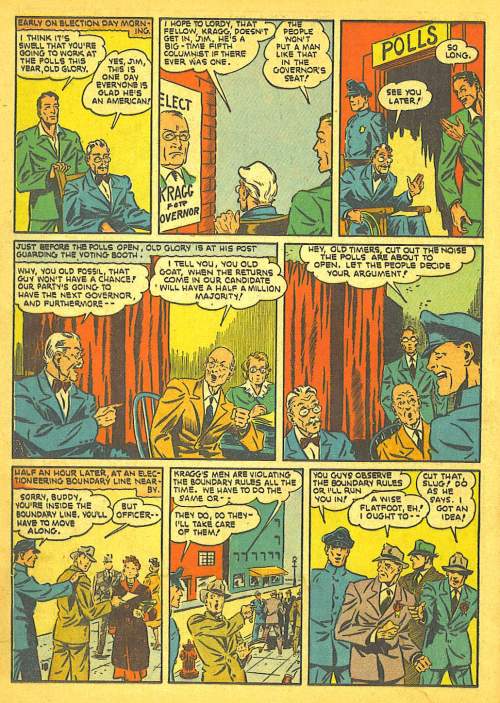




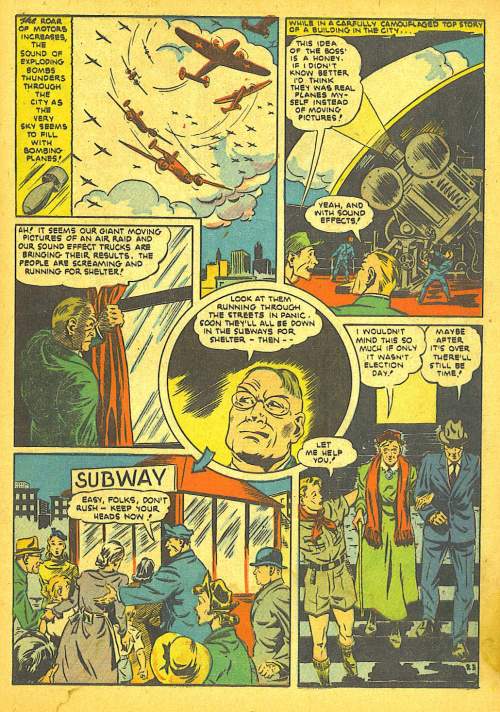


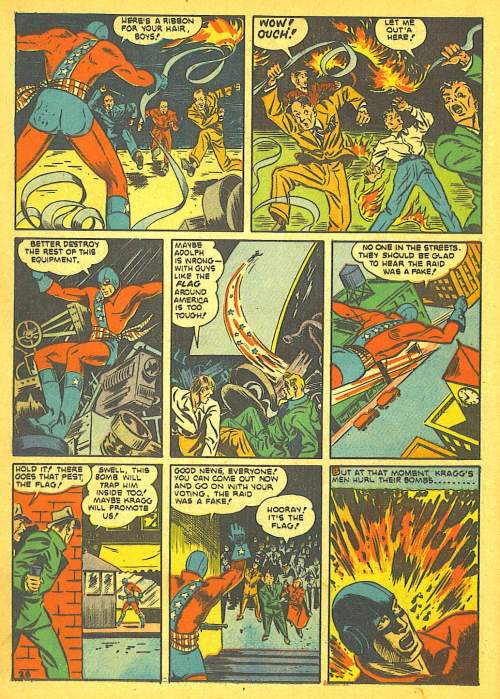
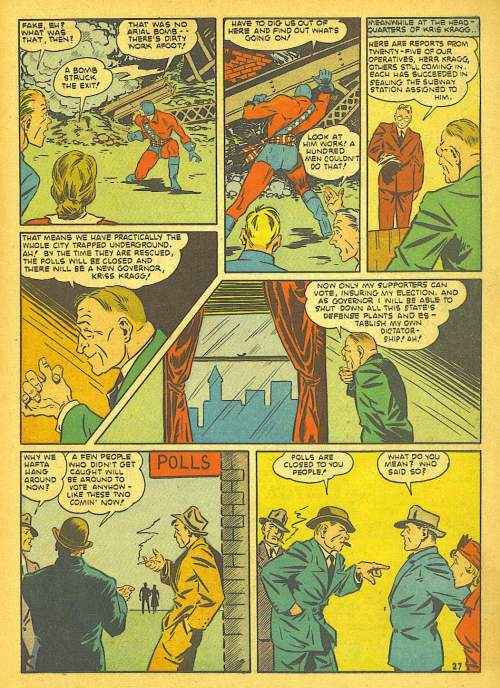
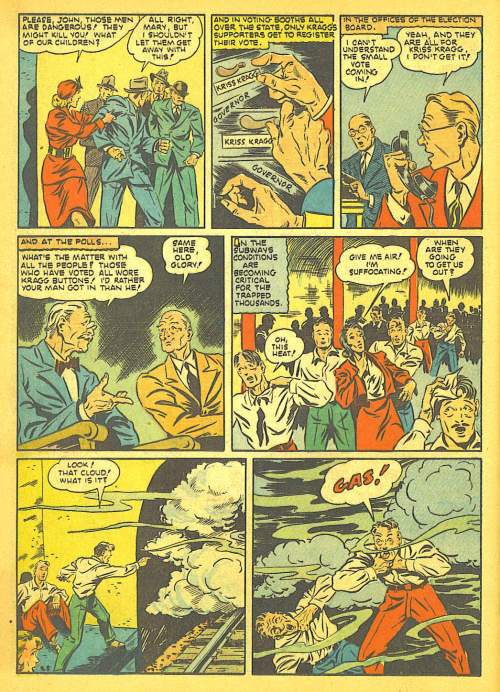

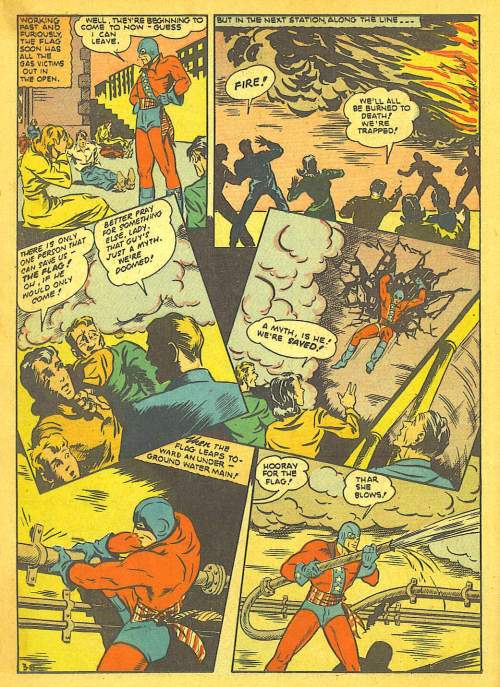

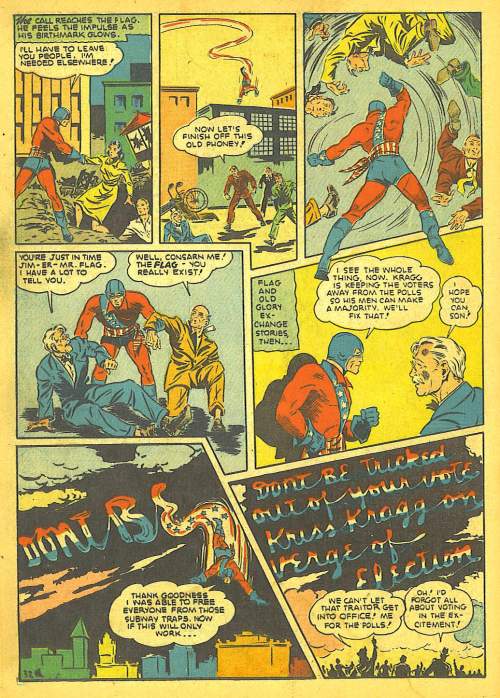



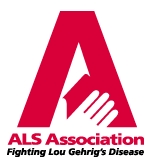


Mar 30, 2012 @ 18:36:59
Jun 27, 2012 @ 18:22:36
Aug 01, 2012 @ 19:41:16